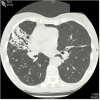Mycobacterium avium Complex: Addressing Gaps in Diagnosis and Management
- PMID: 32814943
- PMCID: PMC7566660
- DOI: 10.1093/infdis/jiaa354
Mycobacterium avium Complex: Addressing Gaps in Diagnosis and Management
Abstract
Nontuberculous mycobacteria (NTM) are ubiquitous in the environment and an important cause of disease. The most common species causing pulmonary disease are members of Mycobacterium avium complex (MAC). MAC pulmonary disease (MAC-PD) can be chronic, debilitating, costly, and associated with a high mortality. However, MAC diagnoses are often delayed due to the nonspecific presentation of MAC-PD and radiological findings that overlap with other pulmonary diseases. Patients with risk factors and who meet the diagnostic criteria-which include clinical, radiological, and microbiologic criteria-should be considered for treatment. Diagnosis requires 2 or more positive sputum cultures or 1 bronchoscopic specimen culture. The recommendation for those who are treated is a 3-drug regimen including macrolide, rifamycin, and ethambutol that is continued for 12 months beyond sputum culture conversion to negative. MAC-PD is difficult to treat, with frequent drug-related side effects and suboptimal treatment outcomes. Refractory and recurrent disease is common, leading to lifelong follow-up of patients. There are limited treatment options for patients with macrolide-resistant or refractory disease. Amikacin liposome inhalation suspension is recommended for treatment-refractory patients whose cultures remain positive after 6 months of guideline-based therapy. Among the research priorities to improve patient outcomes and quality of life are developing new, more rapid diagnostic tests, investigating biomarkers associated with disease progression, and identifying new drugs and routes of administration as well as new, shorter, and better-tolerated regimens.
Keywords: diagnosis; pulmonary disease; refractory disease; risk factors; treatment.
© The Author(s) 2020. Published by Oxford University Press for the Infectious Diseases Society of America.
Figures






References
-
- Mehta M, Marras TK. Impaired health-related quality of life in pulmonary nontuberculous mycobacterial disease. Respir Med 2011; 105:1718–25. - PubMed
-
- Tortoli E, Rindi L, Garcia MJ, et al. . Proposal to elevate the genetic variant MAC-A, included in the Mycobacterium avium complex, to species rank as Mycobacterium chimaera sp. nov. Int J Syst Evol Microbiol 2004; 54:1277–85. - PubMed
MeSH terms
Substances
LinkOut - more resources
Full Text Sources
Medical

